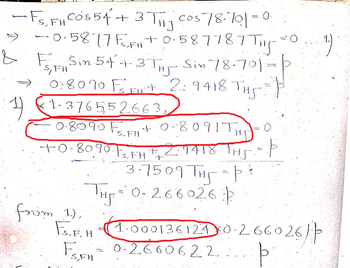➤ Consider FBD of pulley H: F₁, FH 54" Y TBF = 0.2666053799P = 500N TGF = 0.43137655663P = 500 N By applying the equilibrium conditions, we can solve for FS,FH and TH in terms of P. → EF₂ = -FSFH Cos 54 +3TH) cos 78.701 = 0 + EF = FS,FH sin 54 +37HJ sin 78.701 - P = 0 FSFH = 0.2666053799P = (0.250m) (4000N/m) THI= 0.2666045474P = 500 N 3TH1 TBF 78.701" P Because the computed value of FS.FH is positive, it means that spring FH is in tension. To solve for the maximum tensile force the spring can support, the largest possible length of stretch 0.250m is multiplied to the spring constant. 36 > Consider FBD of pulley F: Since we already have the value of FS,FH in terms of P, we can solve for TBF and TGF in terms of P by applying the equilibrium equations. EF=-TBF sin 36+ FFH COS 54 = 0 12F₂=-TBF Cos 36 - FS,FH sin 54 + TGF TGF 54" P= 3750.8620 N P= 1875.4369 N F₁, FH = 0 P = 1875.4310 N P= 1159.080115 N
➤ Consider FBD of pulley H: F₁, FH 54" Y TBF = 0.2666053799P = 500N TGF = 0.43137655663P = 500 N By applying the equilibrium conditions, we can solve for FS,FH and TH in terms of P. → EF₂ = -FSFH Cos 54 +3TH) cos 78.701 = 0 + EF = FS,FH sin 54 +37HJ sin 78.701 - P = 0 FSFH = 0.2666053799P = (0.250m) (4000N/m) THI= 0.2666045474P = 500 N 3TH1 TBF 78.701" P Because the computed value of FS.FH is positive, it means that spring FH is in tension. To solve for the maximum tensile force the spring can support, the largest possible length of stretch 0.250m is multiplied to the spring constant. 36 > Consider FBD of pulley F: Since we already have the value of FS,FH in terms of P, we can solve for TBF and TGF in terms of P by applying the equilibrium equations. EF=-TBF sin 36+ FFH COS 54 = 0 12F₂=-TBF Cos 36 - FS,FH sin 54 + TGF TGF 54" P= 3750.8620 N P= 1875.4369 N F₁, FH = 0 P = 1875.4310 N P= 1159.080115 N
International Edition---engineering Mechanics: Statics, 4th Edition
4th Edition
ISBN:9781305501607
Author:Andrew Pytel And Jaan Kiusalaas
Publisher:Andrew Pytel And Jaan Kiusalaas
Chapter4: Coplanar Equilibrium Analysis
Section: Chapter Questions
Problem 4.125P: The figure shows a three-pin arch. Determine the horizontal component of the pin reaction at A...
Related questions
Question
100%
Don't need to answer the question specified in the problem. I just need to know how to get the highlighted numbers in the second image. Thank you!
Need an answer, ASAP.

Transcribed Image Text:➤ Consider FBD of pulley H:
F₂, FH
54°
TBF
TGF
3TH1
By applying the equilibrium conditions, we can solve for FS,FH and TH in terms of P.
→ EF₂ = -F₁,FH Cos 54 +37H cos 78.701 = 0
4EF₂ = FS.FH sin 54 +37HJ sin 78.701 - P = 0
FS.FR = 0.2666053799P = (0.250m)(4000N/m)
THI = 0.2666045474P = 500 N
78.701"
y
P
Because the computed value of FSFH is positive, it means that spring FH is in
tension. To solve for the maximum tensile force the spring can support, the largest
possible length of stretch 0.250m is multiplied to the spring constant.
36"
> Consider FBD of pulley F:
Since we already have the value of FS,FH in terms of P, we can solve for TBF and TGF
in terms of P by applying the equilibrium equations.
TGF
54"
P= 3750.8620 N
P = 1875.4369 N
F₁, FH
→2F₂=-TBF sin 36 + FFH COS 54 = 0
EF=-TBF cos 36 - FS,FH sin 54 + TGF = 0
0.2666053799P = 500N
0.43137655663P = 500 N
P= 1875.4310 N
P = 1159.080115 N

Transcribed Image Text:PROBLEM 6
A pulley-and-cable assembly supports block W and requires a downward force at P for
equilibrium. Determine the largest tension at P if the tension in the cables were not to
exceed 500 N, the springs were not to stretch by more than 250 mm nor compress by 200
mm, and the tension in the bar were not to exceed 900 N nor the compression greater than
800 N. Also, calculate the deformation in the springs and force in the bar when P is at
maximum. (Use k = 4 kN/m.)
A
15
25°
B
kum
54
www
42
E
W
H
78.701
Expert Solution
This question has been solved!
Explore an expertly crafted, step-by-step solution for a thorough understanding of key concepts.
Step by step
Solved in 3 steps with 3 images

Follow-up Questions
Read through expert solutions to related follow-up questions below.
Follow-up Question
where do these (encircled in red) come from?

Transcribed Image Text:cos 78-701=
~ FS, FH COS 54 + 3 THJ cos"
Tuy
0-5877 FFH+0.587787 Ti15
FS, FM Sin 54 +- 3 TH5 Sin 78-701 = p
0:8090 FS+ 2 9418 THS P
FH
11.376552663,
0-80.90 E
0.90 FS, FH + 0·8091T, = 0
S.FH
+0.8090.
0.Fs.
Fs, FH + 2.9418 THS - P
3.7509 THE P
THE = 0-266026 P
from 1),
F.S.E. H
E FS =
S,FH
1.0001361240-2660
0.2660622.
1).
56026/p
þ
Solution
Knowledge Booster
Learn more about
Need a deep-dive on the concept behind this application? Look no further. Learn more about this topic, mechanical-engineering and related others by exploring similar questions and additional content below.Recommended textbooks for you

International Edition---engineering Mechanics: St…
Mechanical Engineering
ISBN:
9781305501607
Author:
Andrew Pytel And Jaan Kiusalaas
Publisher:
CENGAGE L

International Edition---engineering Mechanics: St…
Mechanical Engineering
ISBN:
9781305501607
Author:
Andrew Pytel And Jaan Kiusalaas
Publisher:
CENGAGE L